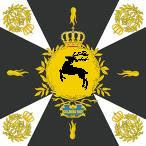 Von Hentsch planned to have his infantry and artillery on some low rises back from the river as his apparent main line, but this was all just a lure. With the Aschenbach troops drawn on, hopefully with their right flank in the air, the Luftberg killing blow could descend from his left wing, a regiment of Cuirassiers and another of Dragoons, along with a full regiment of infantry.
Von Hentsch planned to have his infantry and artillery on some low rises back from the river as his apparent main line, but this was all just a lure. With the Aschenbach troops drawn on, hopefully with their right flank in the air, the Luftberg killing blow could descend from his left wing, a regiment of Cuirassiers and another of Dragoons, along with a full regiment of infantry.Things start well enough with the columns of Aschenbach infantry crossing over, led by a screen of Hussars and then the Grenadier Guards in the lead.
Like clockwork! The infantry cross over and deploy into two lines of a regiment each, plus a battalion in reserve. The only disruption comes from the odd long-range cannon shot and the crackle of musketry from the Croats and irregulars in a small copse over the Steenwijk.
Devil take the hindmost! The lead battalion of Grenadier Guards takes it's orders to full execution, powering on ahead to tackle the enemy line with no thought to the slow and careful deployment behind in the main body. Boldness or Rashness? Time will tell, although the Luftberg line is rattled as Schrammel's infantry regiment takes a pounding.
The hussars try and drive off some Croats to their front, occupying a small bit of woodland. Sadly the Croats prove infuriatingly effective, raining a constant, debilitating fire onto the horsemen and also into the flank of the infantry from across the Steenwijk. Such disorder is intolerable! The Aschenbach deployment out of the bridgehead starts to struggle.
And then, the cavalry are loosed! The two battalions of Cuirassiers charge, supported by the Dragoons, and sweep into the flank the blue infantry were about to occupy. The Hussars, milling about in front of the Croat-filled wood, are sent bowling back and the horsemen crash into the lines of infantry battalions, causing mayhem. Even the king Von Krumper himself gets a nasty scare as squadrons suddenly bear down on his command post!
With all the attacking weight being taken by the cavalry across those flat, marshy fields, the Luftberg infantry struggles to keep pace with the fight. Still, the Grenadier Guards are taught caution by letting themselves get flanked and hit in the front by musket and cannon fire. (When will these damned Grenadiers stop rushing headlong into trouble?!)
Vexed with shot! The Aschenbach infantry units pushed back into the bridgehead find no respite to reform, thanks to the skirmishing fire of crack-shots across the stream. The bluecoats volley back, but it's pretty ineffective and saps the strength now needed to hold off the Luftberg cavalry.
The battle in full swing. The Grenadiers manage to pull themselves back from the tip of the breakout, while the infantry battalions wheel round to fire on the horsemen trying to form for another charge. Both armies have now ended up turned through 90 degrees, fighting at right-angles to their artillery lines. The gunners on both sides of the river send shots ploughing lengthwise down the lines of infantry and cavalry alike. Can nobody get any elbow-room to move around here?
Realising drastic action is needed, Von Krumper calls across his reserve regiment of cavalry from the far bank to try and counter the Luftberg horse. They make it over, but fail to deploy out of column. Desperate to give them some protection and win some room to deploy, he is forced to commit his last untouched reserve unit - the second battalion of the Foot Garde. The grenadiers follow their black-and-yellow regimental banner forwards and fire volleys into the disorganised Luftberg Cuirassiers, buying the Cuirassiers the protection they need.
The Luftberg horse falls back, a spent force. None of the four battalions have been broken, but each one has three hits marked on it and all are disordered. In other words, they're blown, exhausted, incapable of further offensive action. Why, my little nephew Otto could ride them down on his hobby-horse! However, several battalions of Aschenbach infantry have broken up under the charges, the slowly tightening arc of whitecoat infantry, and (above all else) they can't get any peace to recover from disorder or casualties thanks to the endless lashing fire of the irregulars across the whole bridgehead
Losses are heavy for Aschenbach, and many of the remaining units are badly shaken and set to rout if pushed hard. Von Krumper has had enough of this grim field, and orders a withdrawal. The Cuirassiers trot back across, never used in the day's fighting. Following them come several shaken battalions of infantry, glad to get across to the friendly shore. Last out are the hussars and the Grenadiers, forming a tough rearguard that proves off-putting enough for the exhausted Luftberg infantry to fail to pursue. A dejected Von Krumper recrosses the Noordschelve from his untenable bridgehead, the breakout a failure. The poor fellow seems stunned by the calamity!
Over at Felix Von Hentsch's headquarters, it's celebratory schnapps all round! The enemy have lost three out of their seven infantry units and failed to get across the river. Rarely has there been such a spectacular and crushing defeat for Von Krumper, and this represents a personal triumph for Von Hentsch - now in the glory of his greatest and most clear-cut victory!















